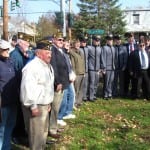Twenty-nine Philipstown residents paid the ultimate price
A beautiful autumn morning greeted the more than 100 local residents who came together just before 11 a.m. on Sunday, Nov. 11, at the memorial below St. Mary-in-the-Highlands Church near Cold Spring’s main intersection. They were there in recognition of Veterans Day, which honors all veterans of the U.S. armed services.
The day was originally established to commemorate Germany’s signing of the Armistice at the 11th hour of the 11th day of the 11th month in 1918, signaling an end to World War I — the war that was to end all wars.
The brief ceremony was organized and hosted by Veterans of Foreign Wars (VFW) Post 2362 and the American Legion, George A. Casey Post 275. Parge Sgro acted as master of ceremonies. In his remarks, guest speaker Roger Keppel, a Vietnam veteran, thanked “all our brave fighting men and women who have underwritten our freedom by their duty, honor and selfless service.” He paid special tribute to those who made the ultimate sacrifice. “Some have given all, laying down their lives to defend freedoms we hold so dear,” he said. “For Philipstown, 29 died in World War I, World War II, and Vietnam.”

Earl Gundersen read the honor roll, 29 local residents who died defending their country. From WWI: Percy W. Arnold, Edward Burns, Walter Croft, Charles DeRam, John R. Fisher, Clarence Fahnstock, James Harvey Hustis, Charles N. Clainos and J. Paulding Murdock. From WWII: Martin Adams, Edward Budney, H. Ellis Bowden, Gaerald Dale, Warren Weitner, W. Russell Farrell, Arthur Gilman, Walter Glaniville, Thomas Lutze, Stanley Matthews, Anthony Nastasi, Allen Olsen, Joseph V. Richardson, Lester F. Roberts, Arthur Warren and Ralph Fleming. FromVietnam: Aldon Asherman, John Bennett and Keith Livermore.
Keppel also made special mention of veterans who have served and continue to serve in the Middle East. “Let us welcome all our troops coming home shortly from Iraq, and hopefully Afghanistan, soon. Welcome them with dignity and respect,” he said. “We thank all their families for the sacrifices their children made for our country. It is our greatest hope that our new veterans obtain decent employment or educational opportunities.”
VFW Chaplain Francis (Terry) Lahey said a prayer for all veterans, and Father Brian McSweeney of Our Lady of Loretto also offered a blessing. Four cadets from the U.S. Military Academy at West Point attended the ceremony.
Perhaps more than any others, two famous poems help capture the essence of Veterans Day, both written by men who served their country in times of war.
In Flanders Fields
By Captain John D. McCrae
In Flanders fields the poppies blow,
Between the crosses, row on row,
That mark our place;
And in the sky the larks, still bravely singing, fly
Scarce heard amid the guns below.
We are the Dead. Short days ago we lived, felt dawn, saw sunset glow,
Loved and were loved, and now we lie in Flanders fields.
Take up our quarrel with the foe.
To you from failing hands we throw the torch;
Be yours to hold it high.
If ye break faith with us who die, we shall not sleep,
Though poppies grow
In Flanders fields.
A note about In Flanders Fields
Why the poppy? During the Napoleonic wars, it was observed that the fields were bright with colorful red poppies before a battle. Strangely enough, it was discovered that the bombardment of these fields helped the poppy to grow. John McCrae’s poem became popular in 1915, and by 1918, Moina Michael began to weave poppies in remembrance of those who had died in WWI while working at a YMCA canteen. Madame Guerin learned of this in 1920 when she visited New York from France. On her return home, she began making poppies to earn money for the children of veterans and war-torn Europe. In the U.S., poppies tend to be worn for Memorial Day, while in other countries they are worn in November.
High Flight
By John Gillespie Magee, Jr.
Oh, I have slipped the surly bonds of earth,
And danced the skies on laughter-silvered wings;
Sunward, I’ve climbed and joined the tumbling mirth
Of sun-split clouds, — and done a hundred things
You have not dreamed of — wheeled and soared and swung
High in the sunlit silence. Hov’ring there,
I’ve chased the shouting wind along, and flung
My eager craft through footless halls of air….
Up, up the long, delirious, burning blue
I’ve topped the wind-swept heights with easy grace.
Where never lark, or even eagle flew —
And, while with silent, lifting mind I’ve trod
The high untrespassed sanctity of space,
Put out my hand and touched the face of God.
A note about High Flight:
During the Battle of Britain, many Americans crossed the border into Canada to enlist with the Royal Canadian Air Force, knowingly breaking the law in order to fight Hitler’s Germany. John Gillespie Magee, Jr. was born in Shanghai, China, in 1922. When Magee was just 18 years old, he entered flight training and was sent to England, on June 30, 1941. He flew the Spitfire and was promoted to the rank of pilot officer. On Sept. 3, 1941, Magee flew a Spitfire V test flight, which inspired him to write his poem. That same day he wrote a letter to his parents, which included his now famous poem. Three months later, on Dec. 11, 1941, John Gillespie Magee, Jr., was killed. He was just 19 years old. He is buried at Scopwick, Lincolnshire, England, in a churchyard cemetery.
Notes adapted from: lovetolearnplace.com






